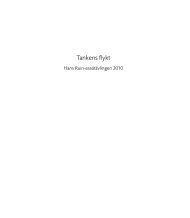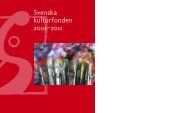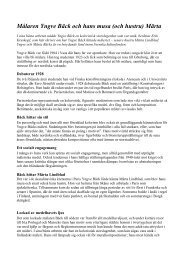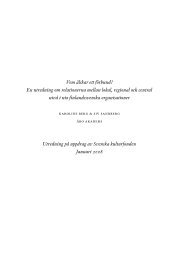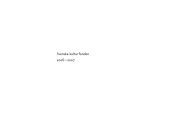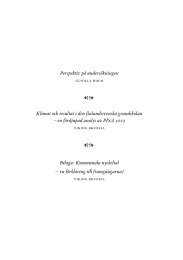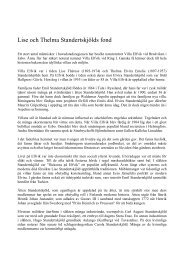Sesam - Svenska kulturfonden
Sesam - Svenska kulturfonden
Sesam - Svenska kulturfonden
You also want an ePaper? Increase the reach of your titles
YUMPU automatically turns print PDFs into web optimized ePapers that Google loves.
With the door as starting point<br />
an contemplation of a site-specific work of art by Johanna Lecklin<br />
Göran Torrkulla<br />
“Man is a creature who makes pictures of himself<br />
and then comes to resemble the picture.”<br />
– Iris Murdoch<br />
A door story in three parts<br />
In the e-mail where she described <strong>Sesam</strong>e, the<br />
site-specific art project of the Swedish Cultural<br />
Foundation in Finland, Project Manager Sofia<br />
Aittomaa wrote that each artist were to make one<br />
or more works with the door as starting point.<br />
Johanna Lecklin’s contribution resulted in a story<br />
in three parts on three doors on the 5th floor of<br />
the offices of the Swedish Cultural Foundation<br />
in Finland at Simonkatu 8 A in Helsinki. The<br />
three doors, both singly and together, manifest<br />
as a site-specific work of art. Below I will attempt<br />
to – without claiming to do justice to this<br />
multilayered work – weave together spontaneous<br />
reactions with retrospective reflections.<br />
The doors were in fact there from before and<br />
as such I would not have paid them any attention.<br />
The words are appear as if they were written in<br />
transparent ink and now suddenly become visible<br />
as I read the brightly white radiating writing<br />
in light (the handwriting of which takes my<br />
thoughts to the school notebook for penmanship<br />
training, which with concentrated persistence<br />
one tried to keep within the supportive), or<br />
as if a hand in front of my eyes on the empty,<br />
rectangular surfaces of the doors were to write<br />
stanzas in regular Swedish and in Johanna<br />
Lecklin’s own natural handwriting in a large<br />
script, here translated into English:<br />
She had stayed<br />
as a guest<br />
in their home,<br />
a temporary<br />
visitor in their<br />
mutual<br />
life.<br />
At home she had<br />
become transparent,<br />
as a forgotten piece<br />
of furniture<br />
in a corner.<br />
It was the fourth<br />
window she looked<br />
out from,<br />
the fourth landscape<br />
she viewed,<br />
before she arrived at<br />
home.<br />
Finally.<br />
The three-part work of art establishes a<br />
clearing of light, which turns spatiality inside out<br />
and calls up the irreal sense of us being able of<br />
walking through walls! Three “ordinary” doors<br />
have as literally as paradoxically transformed<br />
into entrances that– without me even needing<br />
to press down the door handle – allow me to<br />
enter the space that the work on the hinges of<br />
imagination open within me. James Joyce appears<br />
to be in the right, when he in Ulysses claims<br />
that any given object is, through the co-creative<br />
attention of the spectator, able to invoke an<br />
epiphany: a transilluminated moment where<br />
it – to speak with the words of Heidegger in The<br />
Origin of the Work of Art – “shines and wants<br />
only to shine”, and thus appears in its own right.<br />
Through transfiguration or epiphanization the<br />
three doors open an illuminated imaginary space<br />
in the corner of the corridor: a kind of fourth<br />
dimension!<br />
On the whole I perceive the texts themselves<br />
as discreet reminders of the as unpredictable<br />
as quotidian decisive consequences of the<br />
coincidences in the life of a person – reminders,<br />
which allow both the possibilities and the limitations<br />
of the existential circumstances to manifest.<br />
Thereby they bestow a point of reference to our<br />
aspirations and trepidations. The point of reference<br />
maintains the transient contact with the life world<br />
and those life experiences they spring out of.<br />
The Rűckenfigur, or currently both home and away<br />
The laconically concluding single-word sentence<br />
”Äntligen.” (“Finally.”), suggests a searching absence<br />
after which the “she” of the text finds her way home<br />
to herself. In these poetically charged stanzas I<br />
perceive a dynamic tension between presence and<br />
absence, between departure and arrival, as well as<br />
between being comfortable and uncomfortable at<br />
a given place, where one can as easily encounter<br />
home somewhere else, as homecoming can be a<br />
voyage that, so to speak, occurs right there.<br />
My first expression was that this site-specific<br />
work deviates from Johanna Lecklin’s earlier<br />
works. But on second thought, I do believe it<br />
relates to the “chain stories” in the project Story<br />
Café in a way that I regrettably do not here<br />
have space to elaborate upon further. Instead<br />
I will pursue a note from our discussion at the<br />
site on the rainy morning of October 5th 2012:<br />
”Compare the third story with C.D. Friedrich’s<br />
Rückenfiguren”. This in turn led my thoughts to<br />
the four interiors in the series She Had Seven<br />
Dresses For The Trip, Just In Case That They Would<br />
Meet (digital color photographs displayed at the<br />
Finnish Institute of Stockholm in 2012). In these<br />
interiors a lonely woman stands with her back<br />
(more or less) turned towards us. She is in front<br />
of a balcony-facing window in an apartment in an<br />
apartment building. The balcony in turn faces a<br />
wall of apartment building facades.<br />
When I look up Caspar David Friedrich’s Woman<br />
at the Window (1822), where a female form faces<br />
away in a window embrasure and looks out through<br />
the opened shutters towards a harbor (or a sea?)<br />
that we can but divine, it occurs to me that Johanna<br />
Lecklin in her own peculiar way removes the<br />
safety from the pictorial space through perspective<br />
displacements, which expand themselves here<br />
inwards and here outwards, as well as so to speak<br />
multiply the image room to rooms within rooms,<br />
which open towards an open space. With a playful<br />
seriousness she conceptualizes an amalgamation of<br />
sorts of an everyday routine sight and of a sound<br />
alertness, which suggests that we can be both<br />
near and far at the same time. Still it is not a case<br />
of mere daydreaming or romantic long-distance<br />
yearning, but rather of an articulation of varying<br />
states, where it no longer is valid to separate the<br />
intrinsic from the extrinsic. In these images it is<br />
moreover Johanna Lecklin herself, who to the<br />
level of confusion and mistaking changes roles in<br />
different guises. She steps in and out between an<br />
own neck of the woods and an elsewhere, which<br />
in combination with displacements in the position<br />
of the rűckenfigur allows the spectator to see that<br />
which is not visible in the images in themselves.<br />
As with Friedrich, the rűckenfigur functions both<br />
as a point of convergence and at the same time as<br />
a turnstile of sorts, which makes us conscious of<br />
ourselves as spectators. But in contrast to Friedrich,<br />
these interiors keep us willfully in the ”regular”<br />
city apartment with its view over other ”regular”<br />
apartment blocks, and thus awakens the question of<br />
our own relationship with the urban environment<br />
around us. We are in other words allowed to<br />
partake in a multilayered thematization of the<br />
moment of observation by us being invited by the<br />
rűckenfigur to a shared space, which explicates that<br />
existence does not always have to be peremptory<br />
and that absence does not have to be total.<br />
At the same time we are reminded of the<br />
brittle balancing between the intrinsic and the<br />
extrinsic, as well as of the vulnerable in being<br />
exposed to the gazes of others.<br />
A concluding addition that I also could have begun with<br />
The surprises and difficulties we encounter in our<br />
intercourse with art bear in much a resemblance<br />
to the complications we may come across in our<br />
daily intercourse with each other. And as we are<br />
unable to establish the terms for a successful<br />
human relationship, this is equally elusive when<br />
talking of a work of art. On the whole a work of<br />
art has its significance in front of it, in part as<br />
the co-creative contribution of the spectator can<br />
evoke new questions that the artist did not express<br />
and in part since new aspects keep emerging<br />
along with the context where it is incorporated.<br />
As the significance therefore is in continuous<br />
metamorphosis, which does not let it be emptied<br />
once and for all, the encounter with a work of art<br />
imposes upon us the task of – from work to work<br />
and from occasion to occasion – continuously<br />
process our own understanding and endeavor<br />
to comprehend what is tells of ourselves. This is<br />
both easy and difficult. It is easy as we can begin<br />
to dig around where we stand. It is difficult in that<br />
it is ourselves we have to delve into. It is laborious<br />
as we ourselves have to work our way to an own<br />
personal relationship – something that at its most<br />
extreme may present us with the insight that it is<br />
we ourselves that have to change. The rest is an<br />
ongoing story of what the work of art does with us<br />
and of what we ourselves create out of the work!<br />
I hope this short contemplation can invite the<br />
reader to go through Johanna Lecklin’s doors<br />
into the everyday life world, which we are simply<br />
unable to leave, as it exists both around us and<br />
in us, as well as to from now to now search our<br />
finite abode exactly where we are – a task that no<br />
one can take on his or her shoulders in our stead!




